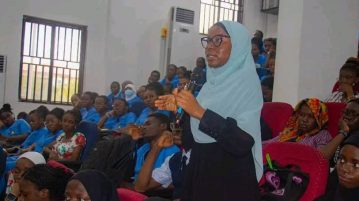I sat down on my consulting chair in the clinic that unforgettable afternoon. I was getting ready to close when I informed the nurse to help call in the next patient. I looked at the folder in my front and I knew the name was familiar. She was brought in supported on each side and was obviously in pain. The fresh air that was previously circulating in the room had become polluted with the smell of fluid dripping from a malignant breast mass.
I instructed her relatives to help lay her down on the couch. I then proceeded with my examination. The tumour was about 10cm in width, she had significant peripheral lymphadenopathy with enlarged nodes at the cervical (neck), axillary (armpit) and inguinal (groin) region . On examining her scalp, there seemed to be a swelling consistent with scalp metastases there. My heart was broken – She was definitely in stage 4 and there was nothing I could do to help her. With the best of chemotherapy, she could barely survive 2 months.
I went to wash my hands, dried them, and returned to sit on my chair. There were beads of sweat forming on my brow in the air-conditioned room. I remembered 18 months ago when she walked into my consulting room looking beautiful after the birth of 2 children. She had complained about a lump she noticed 3 months before then while she was breastfeeding her son and she made up her mind to come immediately she weaned the child off breast milk. I had examined her and it was a small mass; she was very observant to have noticed the mass. I convinced her to have an excisional biopsy done and sent for histology.
I also recalled her sitting in my office about a month after the first encounter holding the histology report. The report said the excised mass was malignant; I was to counsel her for further management. I had carefully explained the full implications of the result and that the definitive treatment was that she needed a mastectomy to totally eliminate the risk of recurrence. She blatantly refused my advice and rebuked the devil. I told her to invite her husband over for discussion which she did. Her husband agreed to the mastectomy but she said it was her body and that she was not going to lose any of her breasts. She absconded from clinic from that day onward and I never saw her again until she was helped into the consulting room.
My heart bled within me as I sat down after examining her. Her husband looked at me with expectant eyes hoping to hear my response. He said she was now ready to do the mastectomy as it was obvious they didn’t have a choice. I was so distraught that I couldn’t look into the face of her husband. All she needed was a simple mastectomy initially and I had been glad we had picked up the tumour at TNM stage 1. I looked up finally to face her husband and explained that she was inoperable. No surgeon was going to wheel her into the theatre.
I referred her to the pain and palliative care unit which gave copious amounts of morphine to help ease her distress. I sat down and reflected on the events of that day. 18 months ago, there was a “willing surgeon” but an “unwilling patient”. That day there was a “willing surgeon”, a “willing patient” but an “impossible procedure”. It was hard to imagine that such a tiny mass would go on to take this woman down to her grave. She didn’t want to lose her breast, but she was going to die with both breasts intact. All these thoughts running through my mind caused a teardrop to involuntarily run down my cheeks. I wondered how many times I was going to cry like this in my general surgery practice in this Sub-Saharan African region.
Breast cancer remains one of the most common causes of cancer death in Africa despite the ability to achieve cure if detected early and treated early. It is worthy to note that research has shown that breast cancer in blacks is more aggressive, discovered at a younger age, and requires more aggressive treatment than as seen in other races. Other factors that propagate death from breast cancer include; late diagnosis, unwillingness to receive treatment, absconding during treatment amongst others.
The following may help mitigate breast cancer deaths and these include; regular breast self-examination, yearly mammography in women above 40, early assessment by a doctor when a lump is found, and willingness to cooperate with treatment modalities especially mastectomy on time.
Help us win this battle against breast cancer.
Help us win the battle against cancer.




